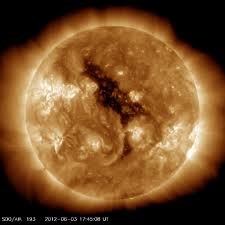Coronal holes
The Sun’s magnetic field has a very complex, constantly changing structure. It can be monitored using images in X-ray and Extreme Ultraviolet wavelengths. In these bands (which allow to observe one of the Sun’s atmospheric layers called corona) bright and dark regions may be distinguished.
The dark regions that extend from the poles towards the equator are called the coronal holes. They form in places of the unipolar magnetic field (+ or -) where the magnetic induction has much lower value than in other, bright regions. They indicate the areas of lower density and existence of open magnetic field lines, which allow the plasma from the solar corona to escape easily into the interplanetary space in the form of high speed solar wind (Coronal Hole High Speed Stream, CH HSS).
Coronal holes may exist for months and if they exist near the solar equator- the connected high speed solar wind can reach the Earth causing a minor to moderate geomagnetic storm. They are the primary sources of geomagnetic storms during the solar minimum activity periods.



 This project (EDU-ARCTIC) has received funding from the European Union’s Horizon 2020 research and innovation programme under grant agreement No 710240. The content of the website is the sole responsibility of the Consortium and it does not represent the opinion of the European Commission, and the Commission is not responsible for any use that might be made of information contained.
This project (EDU-ARCTIC) has received funding from the European Union’s Horizon 2020 research and innovation programme under grant agreement No 710240. The content of the website is the sole responsibility of the Consortium and it does not represent the opinion of the European Commission, and the Commission is not responsible for any use that might be made of information contained.